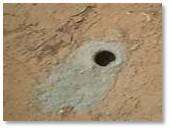Maybe it’s the season with people hanging up stars and singing about stars. Maybe it’s looking up at the Geminid meteor shower or NORAD tracking Santa’s sleigh on Christmas Eve. Maybe it’s not any of those things but the last few weeks have brought some good news from and about outer space. It’s like an early Christmas present for people who love science and space exploration.
Orion Launched
NASA successfully tested America’s newest space vehicle: Orion. The unmanned Orion capsule shot more than 3,600 miles above Earth and returned quickly, splashing down off Mexico’s Baja Peninsula. It worked perfectly.
NASA says, “The cone-shaped Orion held up to all the pressures of launch and ascent into orbit, then made two passes through the high radiation of the Van Allen belts before facing the searing plunge into Earth’s atmosphere and splashing down under three billowing parachutes.”
The Orion capsule is designed to carry astronauts out into the solar system—to MARS and beyond. American is finally reaching for the stars again and, wherever he is, Buzz Lightyear is cheering.
Found on Mars
The Curiosity rover that has been tootling round Mars for a few years now drilled into rock and found some ancient water. They were able to test and it and determine approximately when Mars lost its liquid surface water: about 3.9 billion to 4.6 billion years ago. This is a pretty big range but they also learned that Mars water was heavier than water on Earth.
In addition, Curiosity detected not just the presence of methane on Mars but a spike in the methane levels at its landing site in the Gale Crater during two months of testing. According to Space.com, “Curiosity found that the background level of methane averages out to about 0.7 parts per billion, but the spike brought those levels up to an average of 7 parts per billion, in just 60 Mars days.” NASA scientists speculate that a trapped bit of gas was released from rocks near Curiosity, so we shouldn’t start speculating about life forms of some kind, not even John Carter.
NASA Budget Increased
The House of Representatives just passed its 2015 budget for Commerce, Justice, Science, and related agencies by a vote of 321-87. According to Casey Dreier of The Planetary Society, “NASA, which is included in this bill, is provided with $17.9 billion—$435 million above the President’s 2015 request and $250 million above its 2014 level. The accompanying committee report also directs the Planetary Science Division of NASA to receive a very strong $1.45 billion, nearly $185 million above the budget proposed by the President and very close to The Planetary Society’s goal of $1.5 billion per year.”
Neil DeGrasse Tyson, who recommends building a kind of interstate highway network for the solar system, says, “Not only do you innovate, these innovations make headlines. Those headlines work their way down the educational pipeline. Everybody in school knows about it. You don’t have to set up a program to convince people that being an engineer is cool. They’ll know it just by the cultural presence of those activities. You do that, and it’ll jump-start our dreams.”
Finally @NASA is getting the funding it needs. It looks like we’ll get our heads out of the dirt and have Interstellar dreams.
Do you see what I see? I see progress on space exploration. I see, at long last, a willingness to think beyond the surly bonds of Earth and reach for the Final Frontier. I see an understanding that reinvigorating our space program is good for the United States, good for education, good for inspiration, good for scientific progress, and good for the economy.
After all, given that space is a $300 billion industry worldwide, the United States should be in the forefront. That would give us something to be proud of—and wouldn’t that feel good for a change?
Why NORAD Tracks Santa
And speaking of proud, read this great story from NPR on how NORAD came to track Santa on Christmas Eve. You’ll learn how a military man with a sense of humor and a typo came together to create @NORADSanta and make Christmas more exciting for millions of kids every year.

